Sir John Monash, Personal Files Book 14, 6 October - 30 November 1916, Part 3
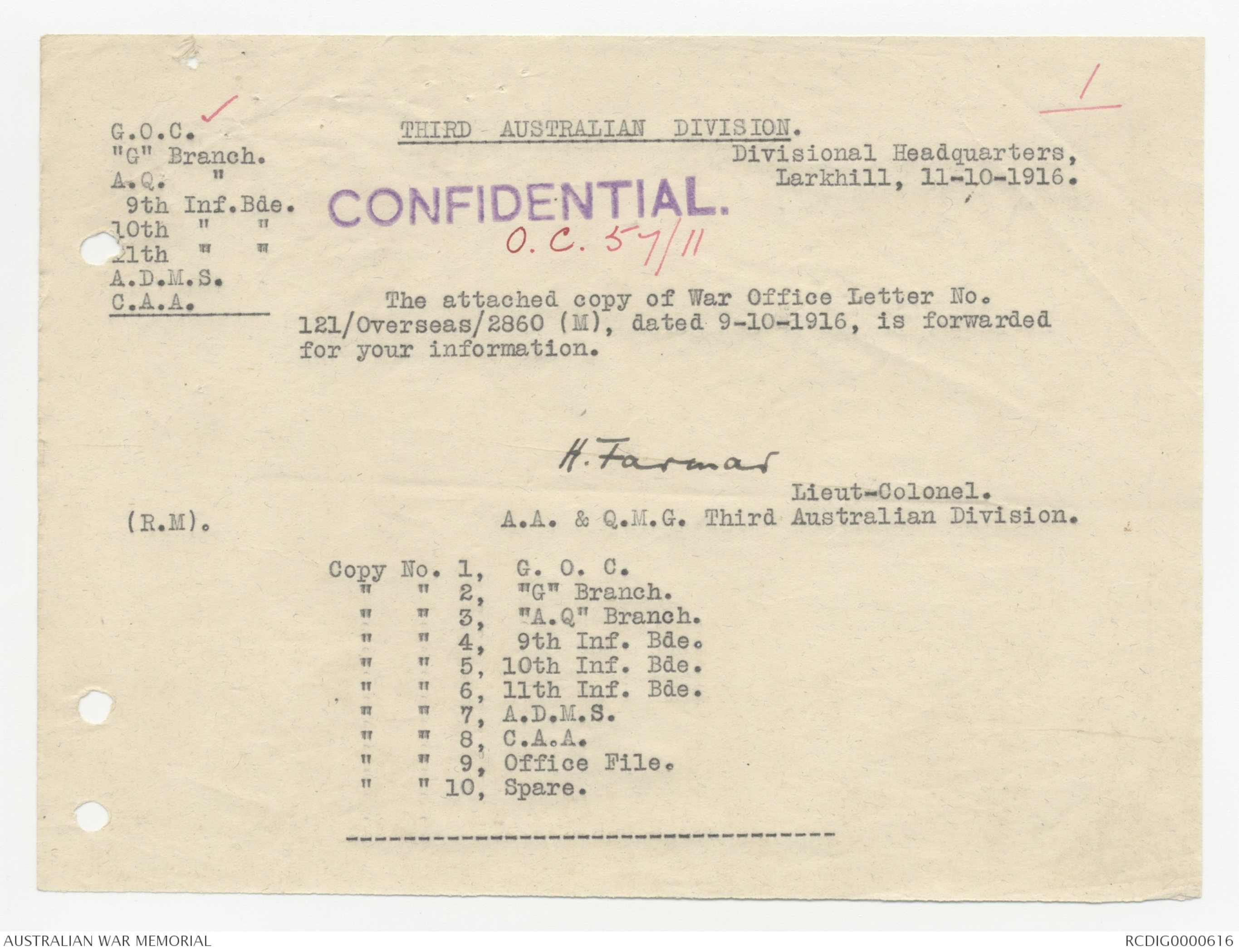
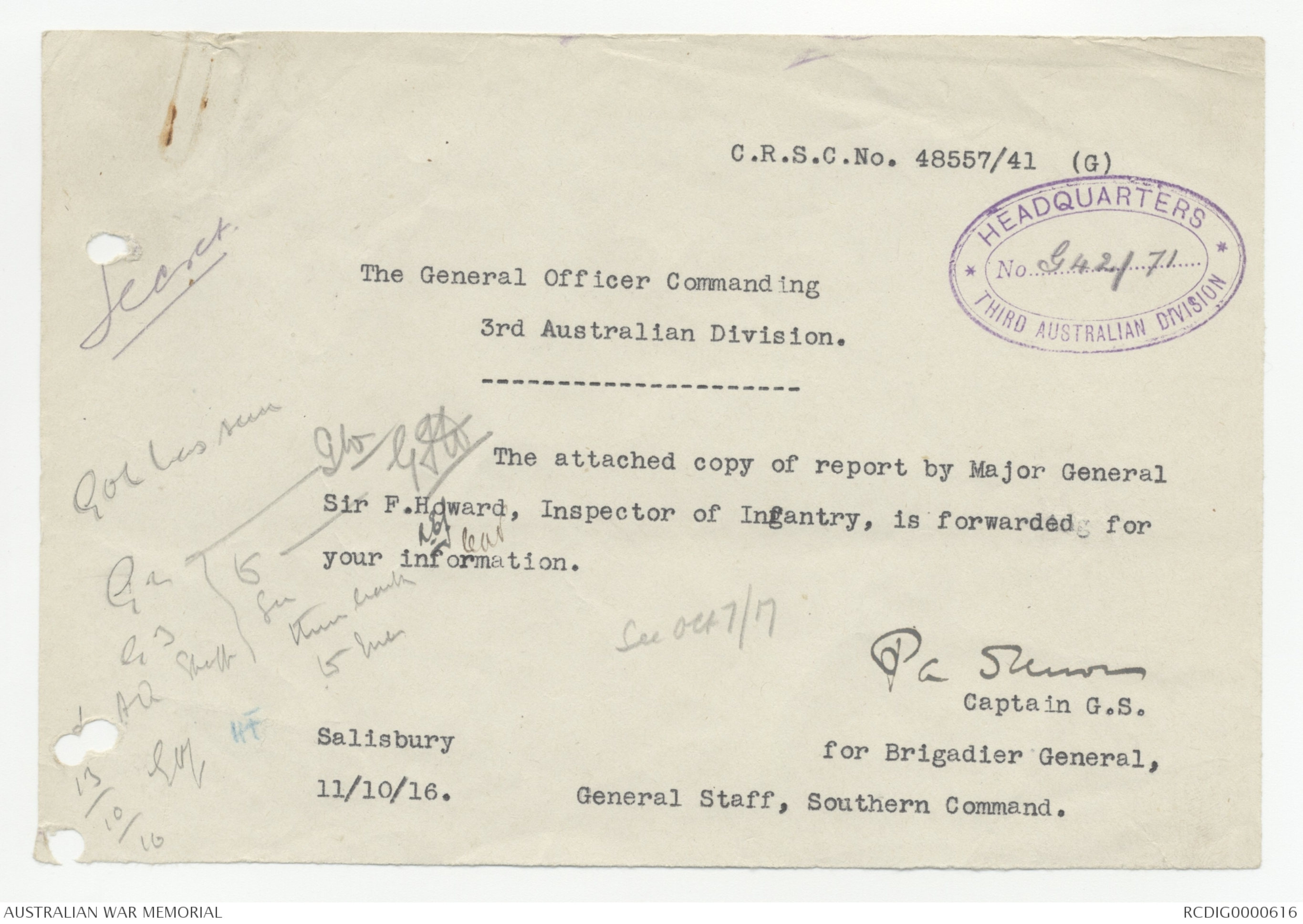
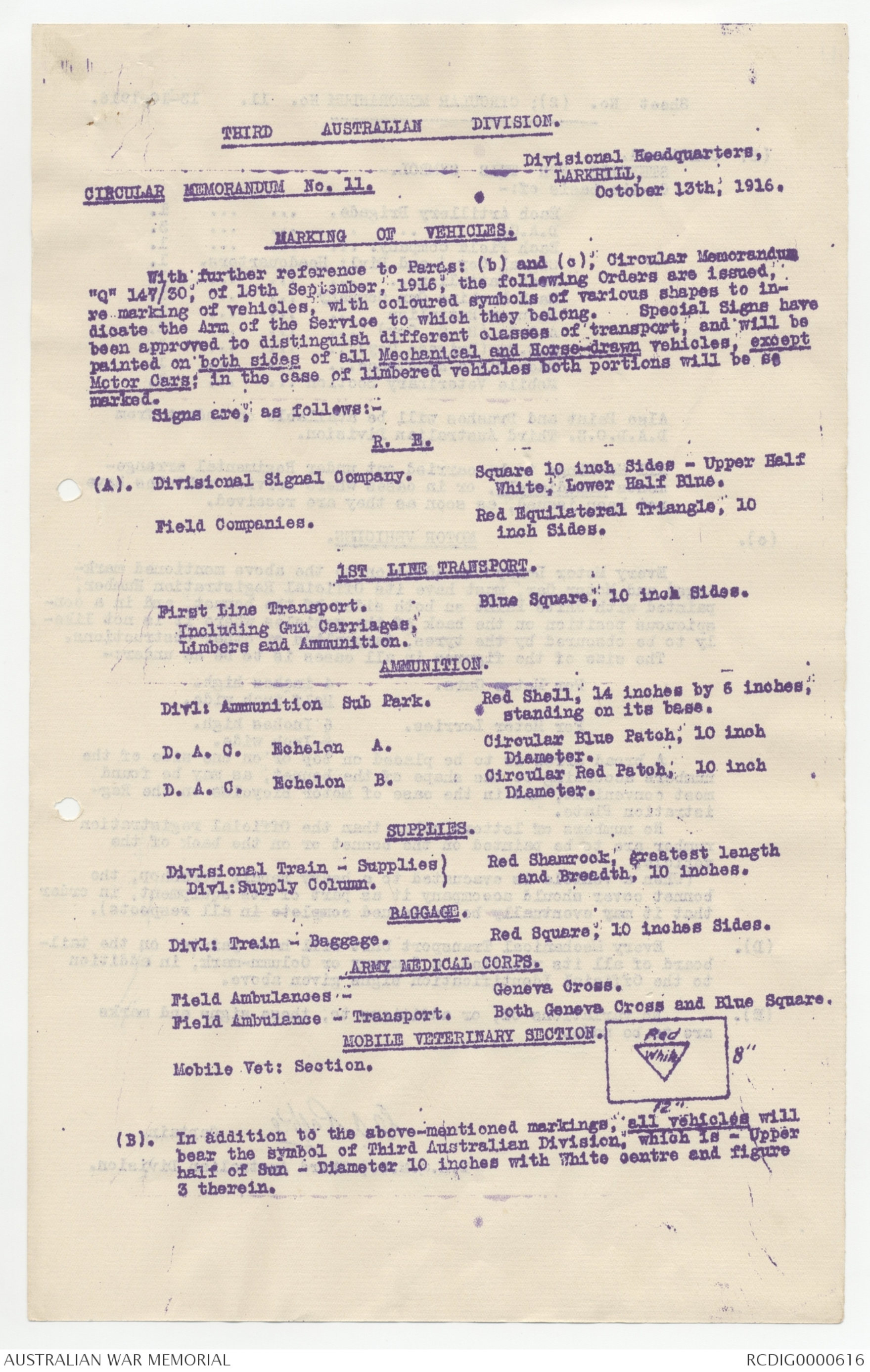
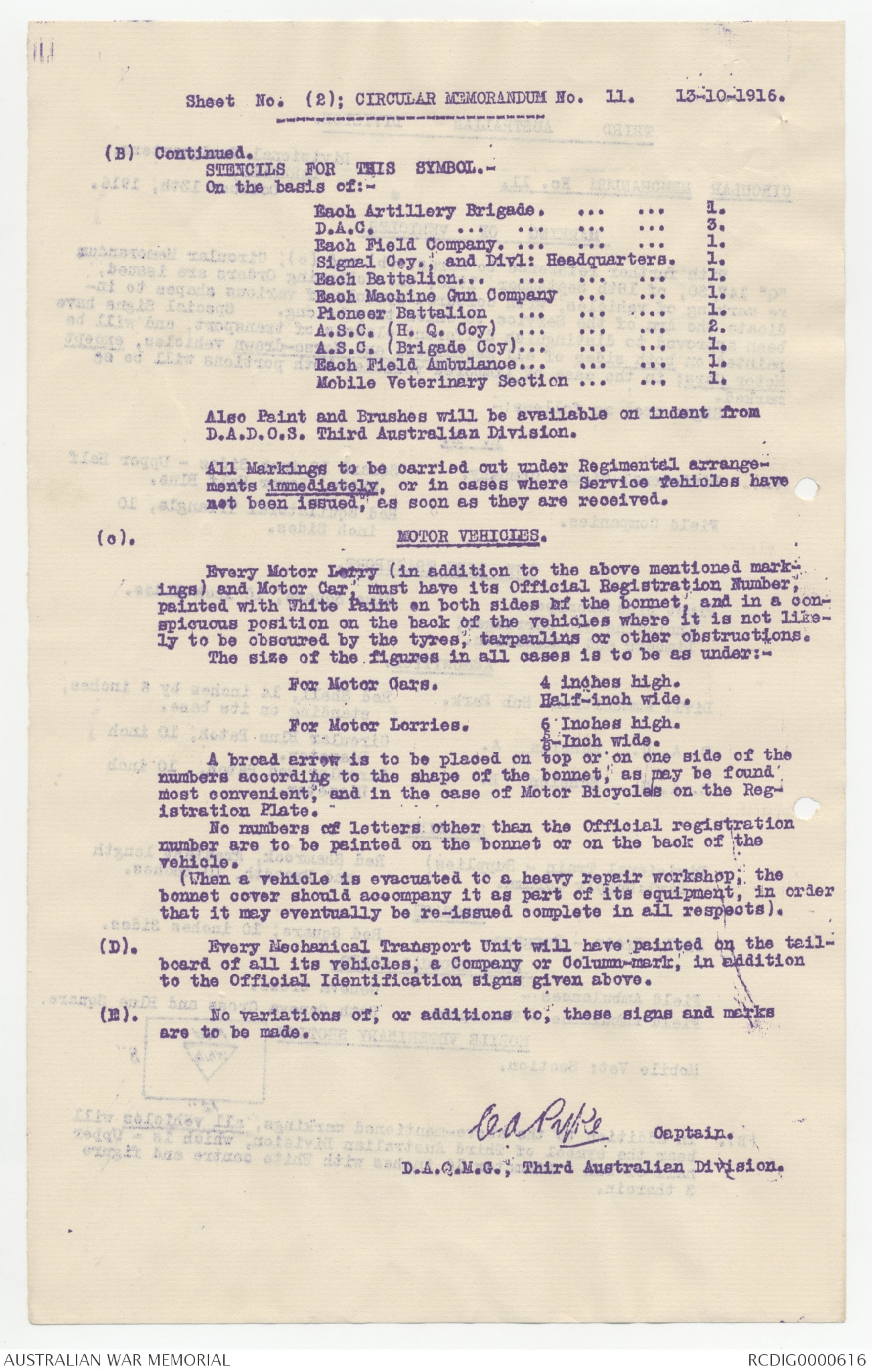
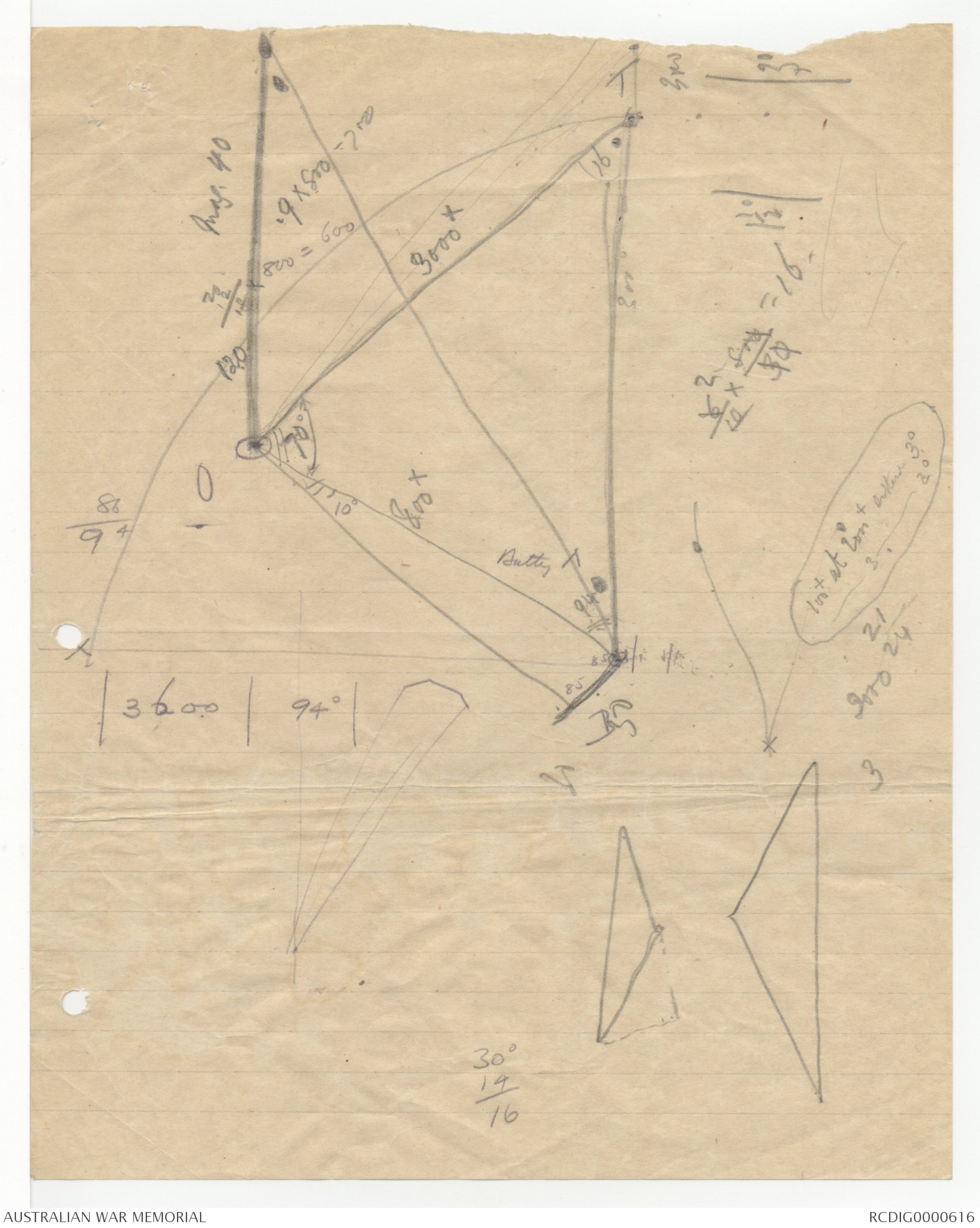
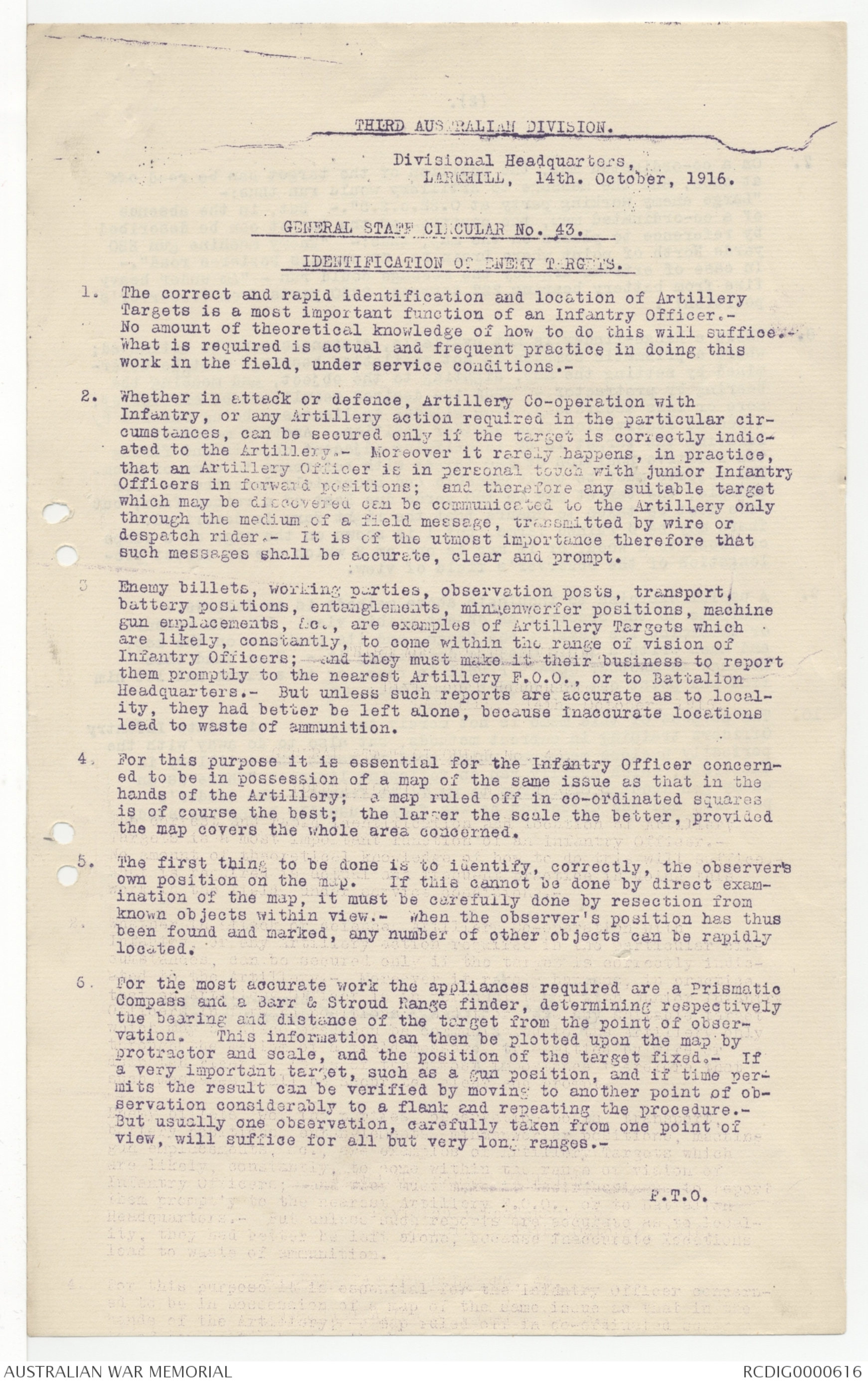
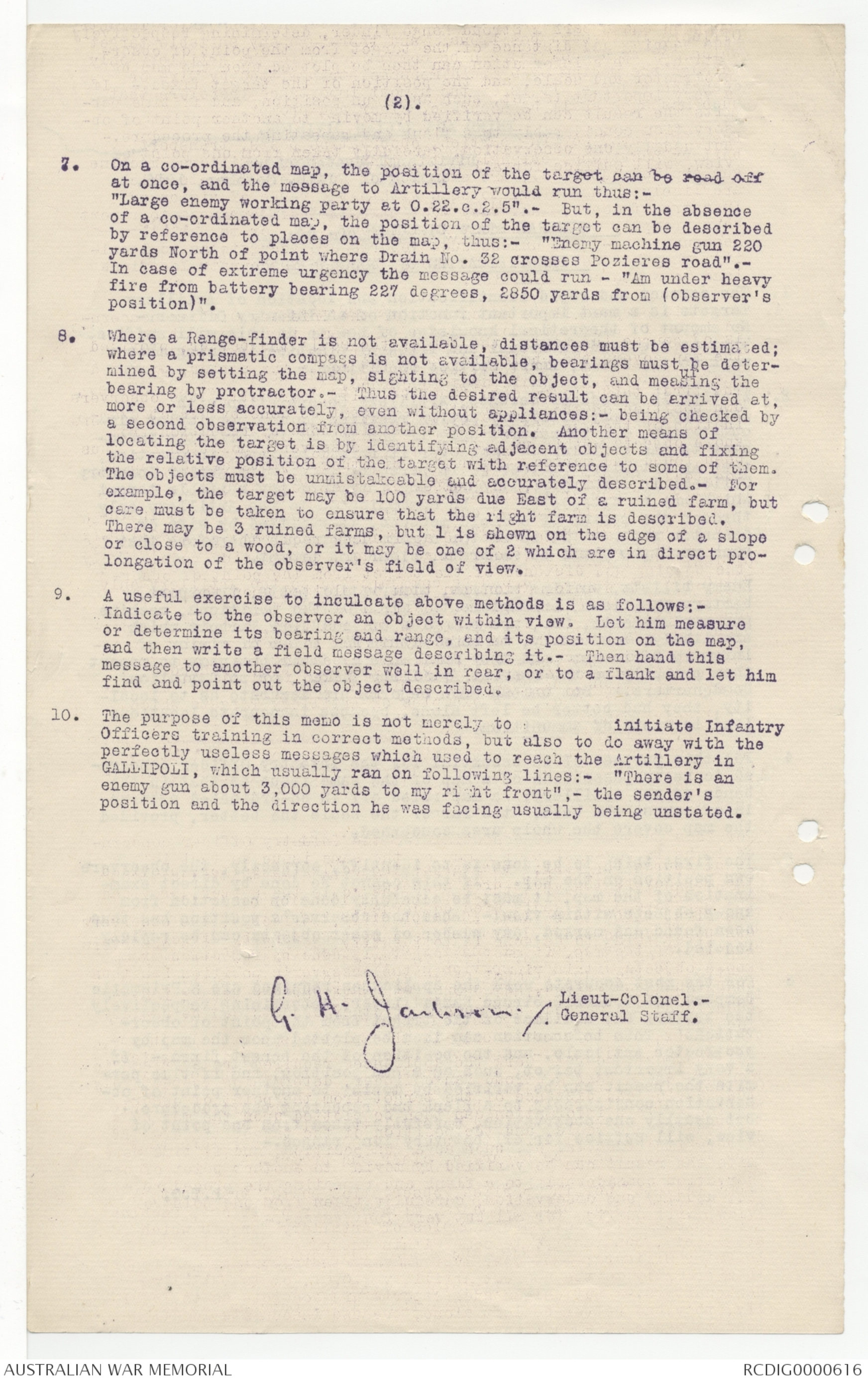
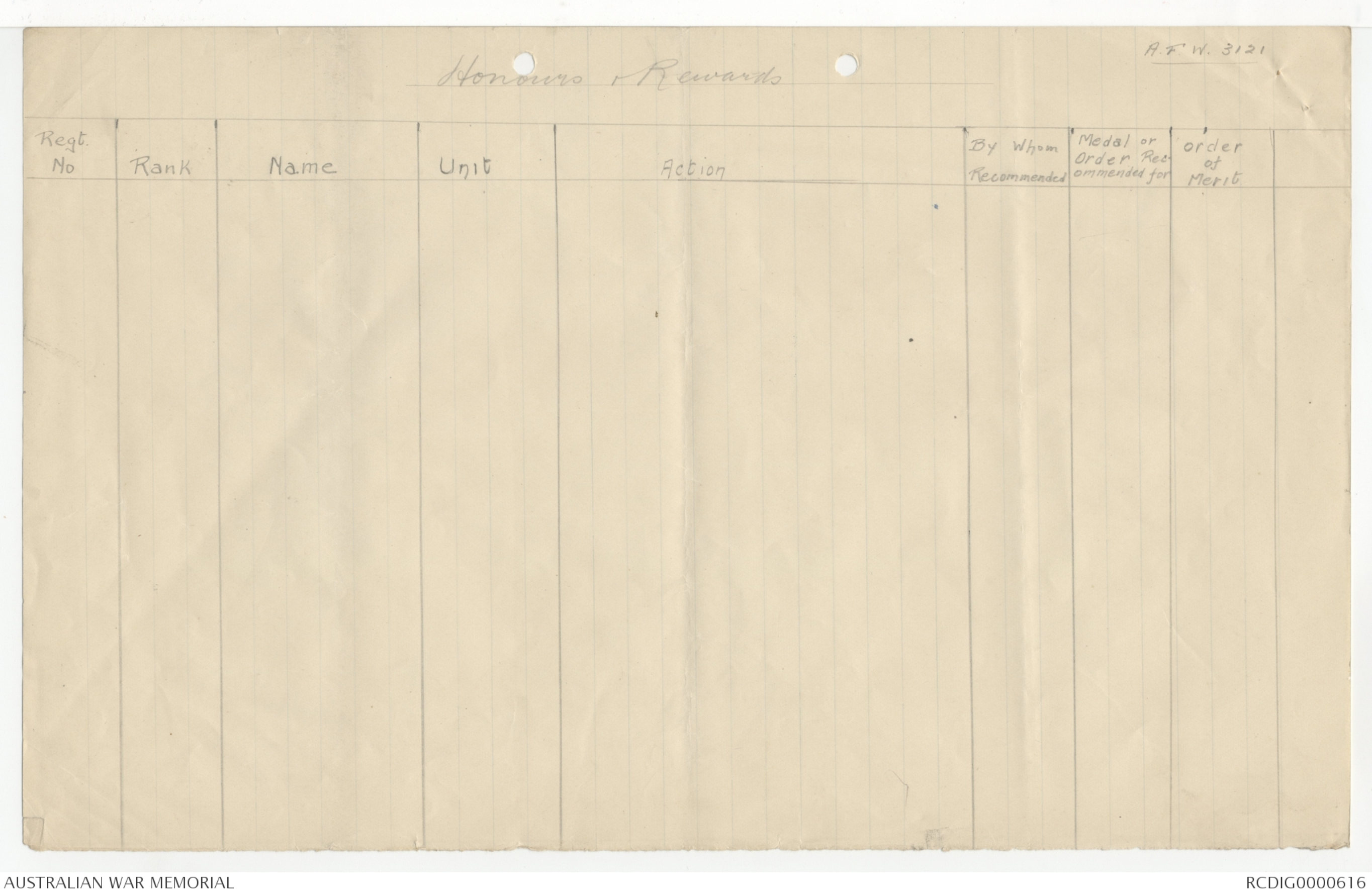
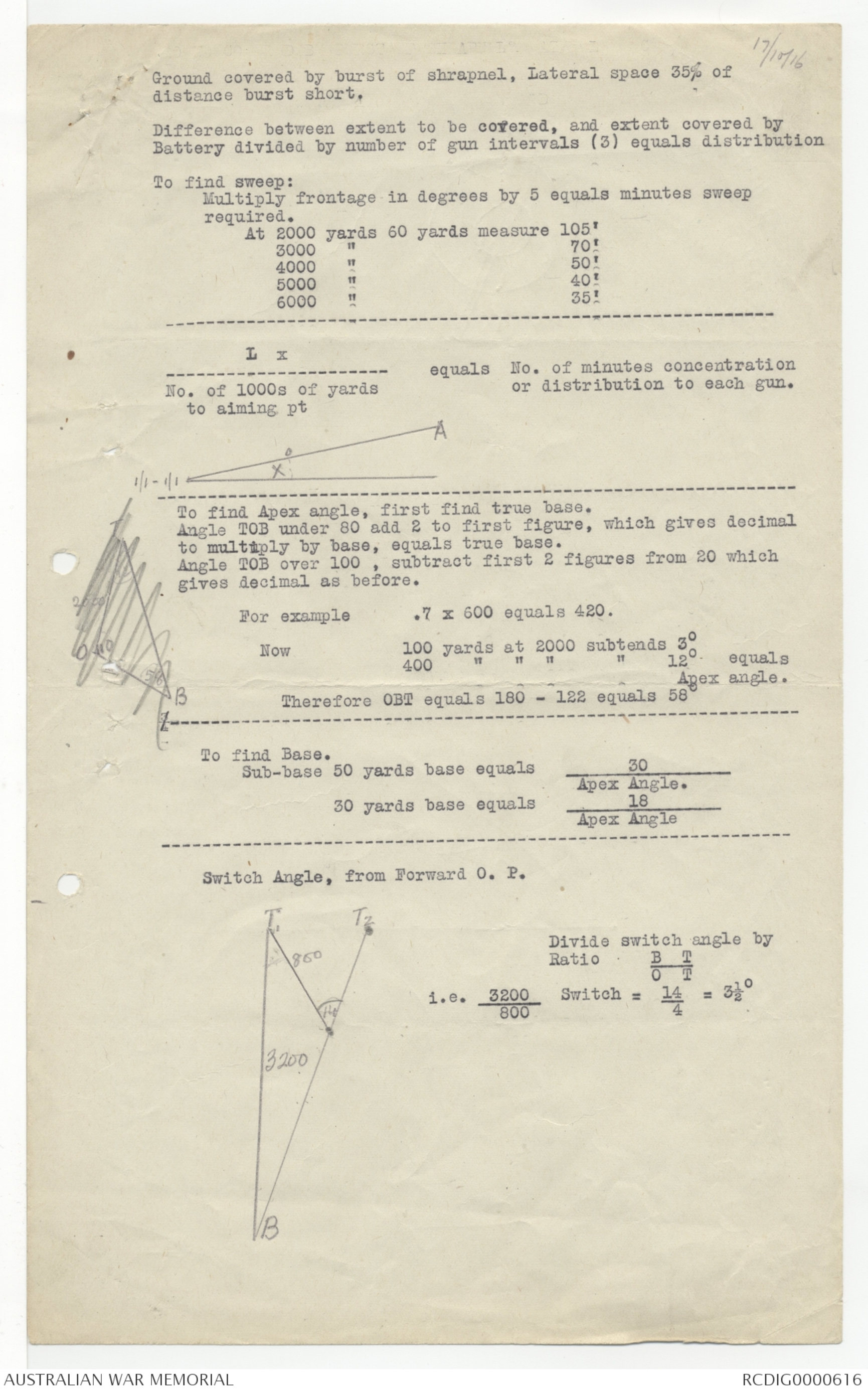
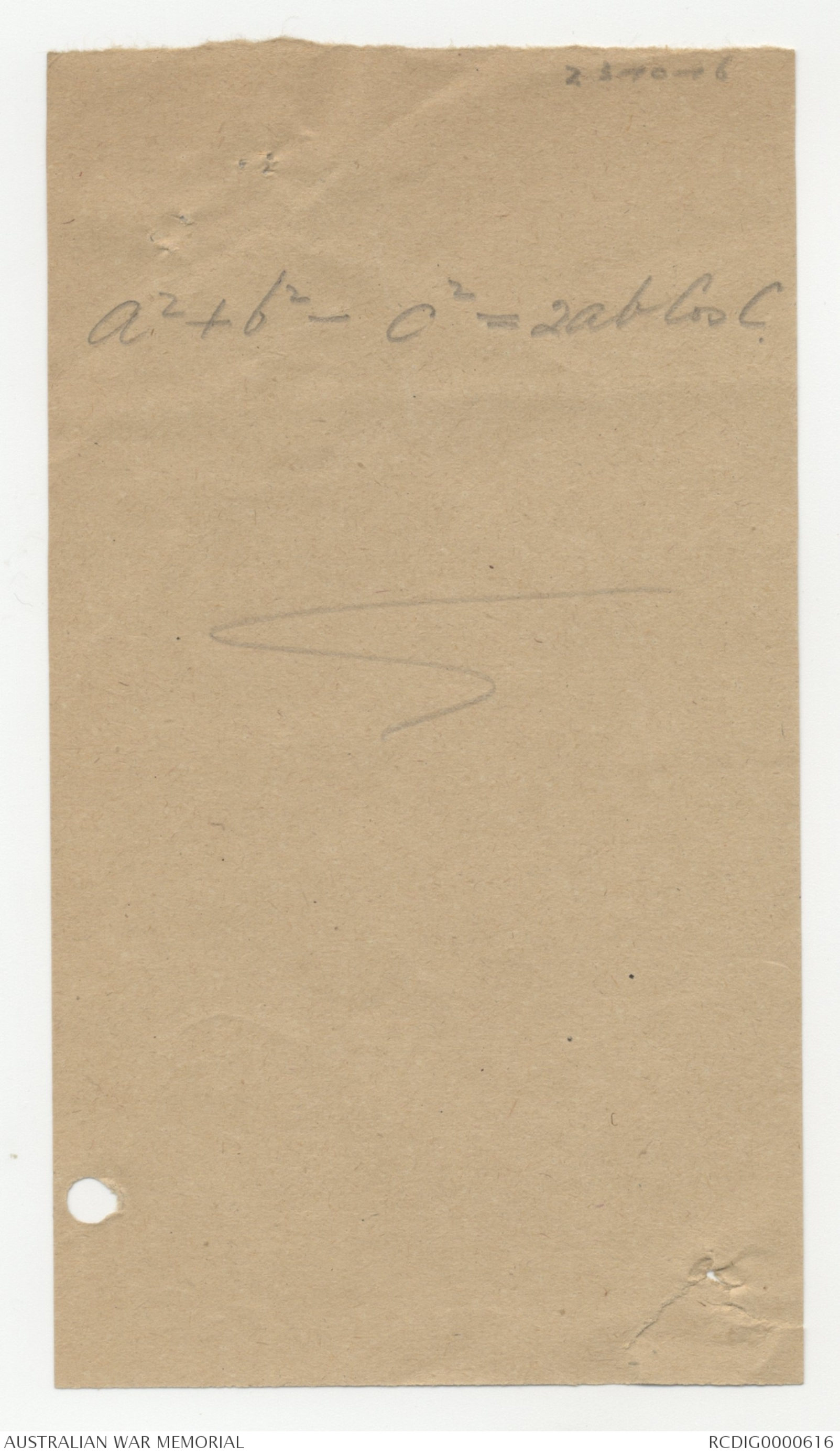
1
THIRD AUSTRALIAN DIVISION.
G.O.C. √
"G" Branch.
A.Q. " Larkhill, 11-10-1916.
9th Inf. Bde.
10th " "
11th " "
A.D.M.S.
C.A.A.
Divisional Headquarters,
Larkhill, 11-10-1916.
CONFIDENTIAL.
O.C. 57/11
The attached copy of War Office Letter No.
121/Overseas/ 2860 (M), dated 9-10-1916, is forwarded
for your information.
H. Farmar
Lieut-Colonel.
(R.M). A.A. & Q.M.G. Third Australian Division.
Copy No. 1, G. O. C.
" " 2, "G" Branch.
" " 3, "A.Q" Branch.
" " 4, 9th Inf. Bde.
" " 5, 10th Inf. Bde.
" " 6, 11th Inf. Bde.
" " 7, A.D.M.S.
" " 8, C.A.A.
" " 9, Office File.
" " 10, Spare.
-------------------------------------
C.R.S.C.No. 48557/ 41 (G)
HEADQUARTERS
THIRD AUSTRALIAN DIVISION
No. G 42/ 71
(*Secret*)
The General Officer Commanding
3rd Australian Division.
---------------------
The attached copy of report by Major General
Sir F.Howard, Inspector of Infantry, is forwarded
for your information.
(*GOC has seen
Gm ) ----------- JW
G3 ) IS--------GH
AQ Staff ) Sn -------RG
Turn back
[[ ? ? ]] *)
(*See Oct 7/17*)
P G Sknow
Captain G.S.
for Brigadier General,
General Staff, Southern Command.
Salisbury
11/10/16.
PG S
Captain G.S.
Salisbury
for Brigadier General,
11/10/18.
General Staff, Southern Command.
THIRD AUSTRALIAN DIVISION.
Divisional Headquarters
LARKHILL,
October 13th, 1916.
CIRCULAR MEMORANDUM No. 11.
MARKING OF VEHICLES.
With further reference to Paras: (b) and (c); Circular Memorandum
"Q" 147/ 30, of 18th September, 1916, the following Orders are issued,
re marking of vehicles, with coloured symbols of various shapes to
indicate the Arm of the Service to which they belong. Special Signs have
been approved to distinguish different classes of transport, and will be
painted on both sides of all Mechanical and Horse-drawn vehicles, except
Motor Cars; in the case of limbered vehicles both portions will be as marked.
Signs are, as follows:-
R. E.
(A). Divisional Signal Company. Square 10 inch Sides - Upper Half White, Lower Half Blue.
Field Companies. Red Equilateral Triangle, 10 inch Sides.
1ST LINE TRANSPORT.
First Line Transport. Blue Square; 10 inch Sides.
Including Gun Carriages,
Limbers and Ammunition.
AMMUNITION.
Divl: Ammunition Sub Park. Red Shell, 14 inches by 6 inches,
standing on its base.
D. A. C. Echelon A. Circular Blue Patch, 10 inch Diameter.
D. A. C. Echelon B. Circular Red Patch, 10 inch Diameter.
SUPPLIES.
Divisional Train - Supplies ) Red Shamrock, Divl:Supply Column. ) greatest length and Breadth, 10 inches.
BAGGAGE.
Divi: Train -Baggage. Red Square, 10 inches Sides.
ARMY MEDICAL CORPS.
Field Ambulances - Geneva Cross
Field Ambulance - Transport. Both Geneva Cross and Blue Square.
MOBILE VETERINARY SECTION.
Mobile Vet: Section. insert here diagram from original.
(B). In addition to the above-mentioned markings, all vehicles will
bear the symbol of Third Australian Division, which is - Upper half of Sun - Diameter 10 inches with White centre and figure 3 therein.
13-10-1916.
Sheet No. (2); CIRCULAR MEMORANDUM No. 11.
-----------------
(B) Continued.
STENCILS FOR THIS SYMBOL.-
On the basis of:-
Each Artillery Brigade. ... 1.
D.A.C. ... 3. Each Field Company. ... 1.
Signal Coy., and Divl: Headquarters. 1.
Each Battalion... ... 1.
Each Machine Gun Company ... 1.
Pioneer Battalion ... 1.
A.S.C. (H. Q. Coy) ... ... ..: 2.
A.S.C. (Brigade Coy) ... ... 1.
Each Field Ambulance.. ... ... 1.
Mobile Veterinary Section ... 1.
Also Paint and Brushes will be available on indent from
D.A.D.O.S. Third Australian Division.
All Markings to be oarried out under Regimental arrangements
immediately, or in cases where Service vehicles have
net been issued, as soon as they are received.
(c).
MOTOR VEHICLES.
Every Motor Lorry (in addition to the above mentioned markings)
and Motor Car, must have its Official Registration Number,
painted with White Paint on both sides of the bonnet, and in a conspicuous
position on the back of the vehicles where it is not likely
to be obscured by the tyres, tarpaulins or other obstructions.
The size of the figures in all cases is to be as under:-
For Motor Cars. 4 inches high.
Half-inch wide.
For Motor Lorries. 6 Inches high.
5/8-Inch wide.
A broad arrow is to be placed on top or on one side of the
numbers according to the shape of the bonnet, as may be found'
most convenient, and in the case of Motor Bicycles on the Registration Plate.
No numbers of letters other than the Official registration
number are to be peinted on the bonnet or on the back of the vehicle.
(When a vehicle is evacuated to a heavy repair workshop; the
bonnet oover should accompany it as part of its equipment, in order
that it may eventually be re-issued complete in all respects).
(D), Every Mechanical Transport Unit will have painted on the tailboard
of all its vehicles; a Company or Column-mark, in addition
to the Offioial Identification signs given above.
(E). No variations of, or additions to, these signs and marks
are to be made.
C. A. Pyke
Captain.
D.A.Q.M.G., Third Australian Division.
This page, Page 5, is entirely taken up with diagrams from the original
THIRD AUSTRALIAN DIVISION.
Divisional Headquarters
LARKHILL, 14th. October, 1916.
GENERAL STAFF CIRCULAR No. 43.
IDENTIFICATION OF ENEMY TARGETS.
1. The correct and rapid identification and location of Artillery
Targets is a most important function of an Infantry Officer.-
No amount of theoretical knowledge of how to do this will suffice.¬
What is required is actual and frequent practice in doing this
work in the field, under service conditions.-
2. Whether in attack or defence, Artillery
Co-operation with
Infantry, or any Artillery action required in the particular circumstances,
can be secured only if the target is correctly indicated
to the Artillery.- Moreover it rarely happens, in practice,
that an Artillery Officer is in personal touch with junior Infantry
Officers in forward positions; and therefore any suitable target
which may be discovered can be communicated to the Artillery only
through the medium of a field message, trarsmitted by wire or
despatch rider.- It is of the utmost importance therefore that
such messages shall be accurate, clear and prompt.
3. Enemy billets, working parties, observation posts, transport,
battery positions, entanglements, minnenwerfer positions, machine
gun emplacements, &etc., are examples of Artillery Targets which
are likely, constantly, to come within the range of vision of
Infantry Officers; and they must make it their business to report
them promptly to the nearest Artillery F.O.O., or to Battalion
Headquarters.- But unless such reports are accurate as to locality
they had better be left alone, because inaccurate locations
lead to waste of ammunition.
4. For this purpose it is essential for the Infantry Officer concerned
to be in possession of a map of the same issue as that in the
hands of the Artillery; a map ruled off in
coordinated squares
is of course the best; the larger the scale the better, provided
the map covers the whole area concerned.
5. The first thing to be done is to identify, correctly, the observers
own position on the map. If this cannot be done by direct examination
of the map, it must be carefully done by resection from
known objects within view.- When the observer's position has thus
been found and marked, any number of other objects can be rapidly
located.
6. For the most accurate work the appliances required are a Prismatic
Compass and a Barr & Stroud Range finder, determining respectively
the bearing and distance of the target from the point of observation.
This information can then be plotted upon the map by
protractor and scale, and the position of the target fixed.- If
a very important target, such as a gun position, and if time permits
the result can be verified by moving to another point of observation
considerably to a flank and repeating the procedure.-
But usually one observation, carefully taken from one point of
view, will suffice for all but very long ranges.
P.T.O.
(2).
7. On a co-ordinated map, the position of the target can be read off
at once, and the message to Artillery would run thus:-
"Large enemy working party at O.22.c.2.5".- But, in the absence
of a co-ordinated map, the position of the target can be described
by reference to places on the map, thus:- "Enemy machine gun 220
yards North of point where Drain No. 32 crosses Pozieres road".-
In case of extreme urgency the message could run - "Am under heavy
fire from battery bearing 227 degrees, 2850 yards from (observer's
position)".
8. Where a Range-finder is not available, distances must be estimated;
where a prismatic compass is not available, bearings must, he determined
by setting the map, sighting to the object, and measuring the
bearing by protractor.- Thus the desired result can be arrived at,
more or less accurately, even without appliances:- being checked by
a second observation from another position. Another means of
locating the target is by identifying adjacent objects and fixing
the relative position of the target with reference to some of them.
The objects must be unmistakable and accurately described.- For
example, the target may be 100 yards due East of a ruined farm, but
care must be taken to ensure that the right farm is described.
There may be 3 ruined farms, but 1 is shown on the edge of a slope
or close to a wood, or it may be ono of 2 which are in direct prolongation
of the observer's field of view.
9. A useful exercise to inculcate above methods is as follows :-
Indicate to the observer an object within view. Let him measure
or determine its bearing and range, and its position on the map,
and then write a field message describing it.- Then hand this
message to another observer well in rear, or to a flank and let him
find and point out the object described.
10. The purpose of this memo is not merely to
initiate Infantry
Officers training in correct methods, but also to do away with the
perfectly useless messages which used to reach the Artillery in
GALLIPOLI, which usually ran on following lines:- "There is an
enemy gun about 3,000 yards to my right front",- the sender's
position and the direction he was facing usually being unstated.
G. H. Jackson/. Lieut-Colonel.-
General Staff.
Page 8 is a table which I have not typed in
(* 17/10/16*)
Ground covered by burst of shrapnel, Lateral space 35% of
distance burst short.
Difference between extent to be covered, and extent covered by Battery divided by number of gun intervals (3) equals distribution
To find sweep :
Multiply frontage in degrees by 5 equals minutes sweep required.
At 2000 yards 60 yards measure 105'
3000 " 70'
4000 " 50'
5000 " 40'
6000 " 35'
----------------------------------------------
L x
-------------------------- equals No. of minutes
No. of 1000s of yards concentration or
to aiming pt distribution to each
gun.
Insert here diagram from original
To find Apex angle, first find true base.
Angle TOB under 80 add 2 to first figure, which gives decimal
to multuply by base, equals true base.
Angle TOB over 100, subtract first 2 figures from 20 which
gives decimal as before.
For example .7 x 600 equals 420.
Now 100 yards at 2000 subtends 3°
400 " " " " 12° equals
Apex angle.
Therefore OBT equals 180 - 122 equals 58
----------------------------------------------------------.
To find Base.
Sub-base 50 yards base equals 30
_____________
Apex Angle.
30 yards base equals 18
_____________
Apex Angle
-------------------------------------------------------
Switch Angle, from Forward O. P.
Divide switch angle by
Ratio B T
_____
O T
i.e. 3200 Switch = 14 = 3½°
_____ ___
800 4
Insert handdrawn diagram here from original
23-10-16
a2 + b2 - c2 = 2ab [[Cos C. ?]]
 Transcriber 27924
Transcriber 27924This transcription item is now locked to you for editing. To release the lock either Save your changes or Cancel.
This lock will be automatically released after 60 minutes of inactivity.